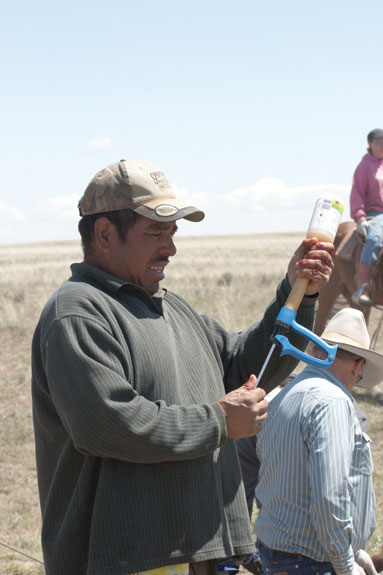This is particularly an optimal time to evaluate your cow vaccination program for reproductive health.
When reviewing your vaccination program, the key question to ask is: “Am I adequately protecting my heifers and cows for reproductive health and minimizing any negative effects on fertility and calving rates?”
Cattle reproductive diseases cost the industry $1 billion each year and generate a loss of $14 per beef cow per year.
Some significant viruses and bacteria that contribute to these losses and can affect fertility and even cause abnormal calves or abortion include: Infectious Bovine Rhinotracheitis (IBR), Bovine Viral Diarrhea (BVD) Type 1 and Type 2, multiple strains of leptospirosis (lepto) and campylobacter fetus (vibrio).

Start with replacement heifers
Starting a replacement heifer’s reproductive career by protecting her from viruses and bacteria is a fundamental part of maximizing an effective cow-herd health program.
By adequately vaccinating heifers, you help prepare them for a successful reproductive life. Heifers that breed early will benefit from early calving and are positioned for repeated success each year – a management practice that pays off during a lifetime.
Implement an effective deworming program
Certain modified-live viral (MLV) vaccines are approved for protection against viral and bacterial agents with one vaccination; however, some heifers may not elicit an optimum immune response due to various physiological and environmental factors, such as parasite burdens.
Minimize the chances of internal parasites being problematic by using a dewormer that will eliminate a high percentage of worms.
Considering some cattle have developed resistance to certain types of dewormers, consult with your veterinarian about an effective program and consider determining the worm egg count by examining 20 fecal samples from each group of animals. The worm egg counts will correlate to the worm burdens in the heifers.
Vaccinate heifers twice after 6 months old
Another factor to consider is that your heifers still could be carrying maternal antibodies from colostrum they received as newborns.
These antibodies may interfere with maximum active antibody response (part of the overall immune response) by heifers.
By assuring that replacement heifers are vaccinated multiple times (at least twice after approximately 6 months old) against viruses and bacteria affecting fertility and pregnancy, you increase the likelihood that they will develop a good immune response to vaccination. For optimal response, heifers also must be in good health and state of nutrition.
Vaccinate heifers at least two weeks pre-breeding
Some MLV vaccines have been proven to elicit what is called cell-mediated immunity (CMI). CMI is the other part of the immune response and can occur, at least as it relates to BVD, in spite of whether or not the heifers still have residual maternal antibodies from the colostrum they received at birth.
CMI is a complex series of immune cells and chemical interactions that help protect the calf against various organisms, such as viruses.
Because of the benefits of CMI, a MLV vaccine should be administered at least twice to non-pregnant replacement heifers. Consult with your veterinarian to determine the time lapse between the last MLV vaccination and exposure to bulls or artificial insemination. This time lapse is generally between two and six weeks.
Cow vaccination program
After your first-calf heifers have calved and become part of the cow herd, you will want to keep cow conception and calving rates high for greatest efficiency and profitability.
To ensure that cows are optimally protected against IBR, BVD, lepto and vibrio for breeding and pregnancy, it is best to vaccinate pre-breeding rather than during pregnancy.
By vaccinating pre-breeding, you establish high levels of protection against diseases that negatively affect conception rates and also provide cows the maximum opportunity to conceive at first estrus rather than during their second or third heat cycle.
Benefits of first-estrus breeding
Calves born during the first part of the calving season – for both spring-calving and fall-calving herds – tend to wean heavier than calves born later due to increased age.
For spring-calving herds, early calves also are at the right age to take advantage of higher-protein grass conditions, which also contributes to heavier weaning weights.
These additional pounds translate into dollars. Vaccination pre-breeding, as opposed to during the middle or last trimester of pregnancy, also provides protection in the earlier stages of gestation when the fetus is most vulnerable to viruses and bacteria that can cause congenital defects and abortion.
Help prevent calf diseases
Protection from pre-weaning diseases, such as bovine respiratory disease (BRD) and clostridial infections, is a good reason to make vaccination an annual pre-breeding event. When cows have been sorted from calves to facilitate vaccination, you have an excellent opportunity to vaccinate your calves.
By vaccinating calves with a modified-live, BRD-preventive viral vaccine in their first few weeks or months of life, you give their immune systems an opportunity to recognize vaccine antigens and respond by eliciting a CMI response.
The calves will then be able to withstand a health challenge better during their first few months of life. Additionally, memory cells that became programmed with vaccination to defend against specific viruses and bacteria will react quickly when calves are revaccinated at pre-weaning, the time of weaning and/or post-weaning.
Your veterinarian can help design a vaccination program that best meets the needs of your herd. At the end of the day, if you simply take time during pre-breeding to invest in their future, you can help keep your herd’s health on track. After all, their future is your future. ![]()
Vaccinating calves with a modified-live, BRD-preventive viral vaccine in their first few weeks gives the immune system an opportunity to recognize vaccine antigens. Photo courtesy of Progressive Cattleman staff.










